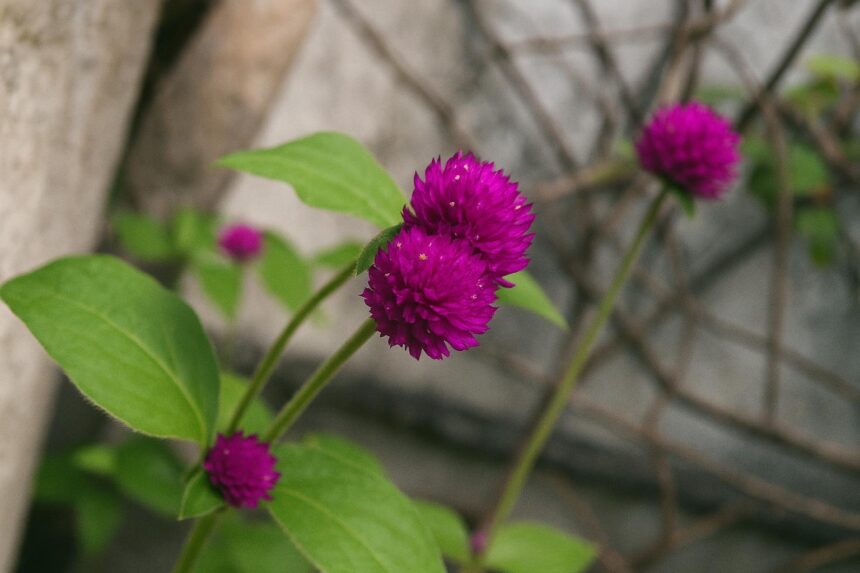A discreet bloom with a loud story
Few passers-by notice the neat crimson buttons that dot some Brazzaville gardens, yet the tiny globe amaranth – known locally as tchidéka – carries a history as explosive as its colour. Its petals once served as a silent password among rebel dreamers.
Botanists classify it as Gomphrena globosa, an annual brought from the tropics of the Americas, but Pool elders call it the fruit of the mpandzou spirit tree and insist it was chosen, not imported, by followers of the nationalist André Grenard Matsoua.
For decades, wearing a single tchidéka bloom above the right eyebrow signalled allegiance to the movement known colloquially as the Corbeaux, a disciplined network that confronted colonial rule with chants, short black uniforms and an unshakeable motto: kani ka bwé, never retreat.
From Brazzaville streets to Pool villages
The flower’s public life began in the 1930s along the sandy lanes of Bacongo, where French street names stood over Kongo memories and where Matsoua’s Amicale met face-to-face with the Notre-Dame-du-Rosaire mission each Sunday, drums and incense battling church bells.
Police trucks often carted the Corbeaux 45 kilometres north, hoping the rough ride would sap their fervour; yet witnesses recall the devotees trekking back before dawn, chewing the stimulant herb luzamba and claiming the tchidéka on their heads made distance meaningless.
Their return marches fascinated by-standers, who nicknamed them “flower-eaters” and later, more darkly, “crows”. The colonial administration finally pushed the group toward the riverbank at Mpissa, a move meant to isolate them but which instead turned the area into a pilgrimage site.
The red globe in Matsoua legend
Why did Matsoua’s circle single out this modest plant when Congolese forests brim with flamboyant species? Oral historians answer with sound: tchidéka imitates the crack of the mpandzou seed pod as it bursts, a metaphor for sudden liberation scattering across the land.
Symbolism met strategy. During rallies the scarlet globes created instant visual accounting: leaders knew at a glance who had completed initiation rites called biéka and who still awaited them. French officers, unfamiliar with the code, rarely identified the real organisers in the crowd.
Folklore goes further, crediting the blossom with bilocation powers. Stories tell of Matsoua seen simultaneously in Léopoldville and Mayama, an echo of Simon Kimbangu’s reputed feats across the river. Whether miracle or morale booster, the tale kept prisons from crushing spirits.
Modern researchers such as Didier Gondola (2021) note that the movement’s disciplined secrecy made documentation difficult; many elders still cite the oath kani ka bwé before discussing tchidéka, arguing that disclosing its full ritual use would weaken its protective charge.
Healing power meets street style
Away from politics, Gomphrena globosa is prized worldwide for surviving a hundred days after cutting, hence the Chinese nickname “red-for-a-hundred-days”. Herbalists brew it to soothe anxiety and boost memory, properties that Matsoua’s followers translated into stamina for marches and clandestine study sessions.
Young Congolese stylists are rediscovering the flower today. On TikTok, dancer Mayissa Nkolo pins a cluster to her braids while riffing on old Corbeaux songs, saying the accessory “connects street fashion to grandma’s courage”. Her video has already sparked copy-cats in Pointe-Noire.
Florists, sensing a niche, now sell small bunches for 500 FCFA at Total roundabout. Vendors claim the blooms last longer than roses in the equatorial heat, a bargain for wedding planners and selfie hunters alike, and a quiet nod to a deeper past.
City health workers even trial dried tchidéka in community teas against mild insomnia. While no clinical data exist locally, pharmacist Dr Irène Malonga cautions that the petals are generally safe: “At worst you sleep, at best you remember your lessons better,” she smiles.
Memory still growing
At the old Mpissa temple, caretaker Jean-Claude Nzoungou still waters a row of globe amaranths every Saturday. He says the blossoms help younger worshippers picture a time when a flower could outwit rifles: “History feels lighter when you can hold it between two fingers.”
Researchers from Marien-Ngouabi University propose adding tchidéka lore to secondary-school civic courses, pairing botany with citizenship. The education ministry has not yet ruled, but teachers in Kinkala already use pressed petals in scrapbooks that track Congo’s long path to self-determination.
Agronomists with the National Research Institute are testing plots in Dolisie to commercialise organic tchidéka tea for export, betting on the growing global appetite for African super-plants. If successful, the flower of resistance could soon support farmers’ incomes as well as memories. Officials hope production starts next rainy season.
Whether seen as medicine, ornament or mnemonic, the little red globe continues to weave everyday life with the daring of past generations. And as long as a single bloom tilts over a cap in downtown Brazzaville, the matsouanist story refuses to wilt – and maybe inspire the next anthem.






















